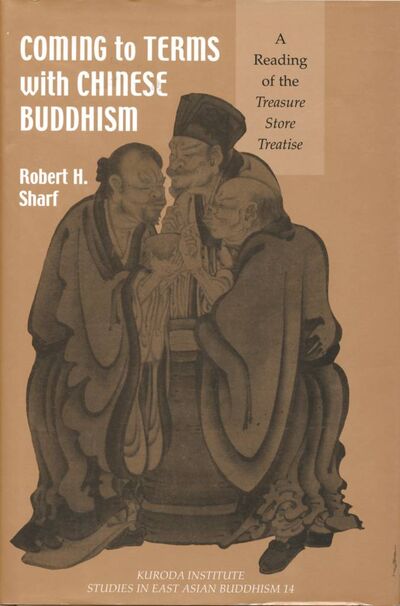Coming to Terms with Chinese Buddhism
< Books
| Line 5: | Line 5: | ||
}} | }} | ||
|FullTextRead=No | |FullTextRead=No | ||
| − | |BookToc=ACKNOWLEDGMENTS ix | + | |BookToc=*{{i|ACKNOWLEDGMENTS|ix}} |
| − | ABBREVIATIONS xi | + | *{{i|ABBREVIATIONS|xi}} |
| − | CONVENTIONS OF USAGE | + | *{{i|CONVENTIONS OF USAGE|xi}}i |
| − | Introduction: Prolegomenon to the Study of Medieval Chinese | + | *{{i|Introduction: Prolegomenon to the Study of Medieval Chinese<br> Buddhist Literature|1}}<br<br> |
| − | Buddhist Literature 1 | + | *''Part 1: The Historical and Cosmological Background'' |
| − | Part 1: The Historical and Cosmological Background | + | *{{i|1. The Date and Provenance of the Treasure Store Treatise|31}} |
| − | 1. The Date and Provenance of the Treasure Store Treatise 31 | + | *{{i|2. Chinese Buddhism and the Cosmology of Sympathetic Resonance|77}}<br><br> |
| − | 2. Chinese Buddhism and the Cosmology of | + | *{{i|''Part 2: Annotated Translation of the Treasure Store Treatise''<br> Introduction to the Translation|137}} |
| − | Sympathetic Resonance 77 | + | *{{i|3. The Treasure Store Treatise/Chapter One<br> The Broad Illumination of Emptiness and Being|143}} |
| − | Part 2: Annotated Translation of the Treasure Store Treatise | + | *{{i|. The Treasure Store Treatise/Chapter Two<br>The Essential Purity of Transcendence and Subtlety|193}} |
| − | Introduction to the Translation 137 | + | *{{i|5. The Treasure Store Treatise/Chapter Three<br>The Empty Mystery of the Point of Genesis|228}}<br><br> |
| − | 3. The Treasure Store Treatise/Chapter One | + | *{{i|Appendix 1: On Esoteric Buddhism in China|263}} |
| − | The Broad Illumination of Emptiness and Being 143 | + | *{{i|Appendix 2: Scriptural Quotations in the Treasure Store Treatise|279}} |
| − | + | *{{i|NOTES|287}} | |
| − | The Essential Purity of Transcendence and Subtlety 193 | + | *{{i|WORKS CITED|345}} |
| − | 5. The Treasure Store Treatise/Chapter Three | + | *{{i|INDEX|379}} |
| − | The Empty Mystery of the Point of Genesis 228 | ||
| − | Appendix 1: On Esoteric Buddhism in China 263 | ||
| − | Appendix 2: Scriptural Quotations in the Treasure Store Treatise 279 | ||
| − | NOTES 287 | ||
| − | WORKS CITED 345 | ||
| − | INDEX 379 | ||
|AddRelatedTab=No | |AddRelatedTab=No | ||
}} | }} | ||
Revision as of 17:10, 18 June 2020
The issue of sinification—the manner and extent to which Buddhism and Chinese culture were transformed through their mutual encounter and dialogue—has dominated the study of Chinese Buddhism for much of the past century. Robert Sharf opens this important and far-reaching book by raising a host of historical and hermeneutical problems with the encounter paradigm and the master narrative on which it is based. Coming to Terms with Chinese Buddhism is, among other things, an extended reflection on the theoretical foundations and conceptual categories that undergird the study of medieval Chinese Buddhism.
Sharf draws his argument in part from a meticulous historical, philological, and philosophical analysis of the Treasure Store Treatise (Pao-tsang lun), an eighth-century Buddho-Taoist work apocryphally attributed to the fifth-century master Seng-chao (374–414). In the process of coming to terms with this recondite text, Sharf ventures into all manner of subjects bearing on our understanding of medieval Chinese Buddhism, from the evolution of T’ang “gentry Taoism” to the pivotal role of image veneration and the problematic status of Chinese Tantra.
The volume includes a complete annotated translation of the Treasure Store Treatise, accompanied by the detailed exegesis of dozens of key terms and concepts. (Source: University of Hawai'i Press)
| Citation | Sharf, Robert, trans. Coming to Terms with Chinese Buddhism: A Reading of the Treasure Store Treatise. Kuroda Studies in East Asian Buddhism 14. Honolulu: University of Hawai'i Press, 2002. https://archive.org/details/comingtotermswithchinesebuddhismareadingofthetreasurestoretreatiserobertsharfh._635_q/mode/2up. |
|---|---|

